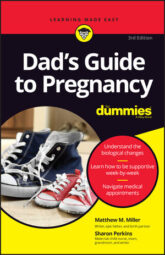Cesareans comprise over 30 percent of deliveries in the United States, so the odds of having one are high. As a new dad, you may want some information about this procedure. Although Cesareans are major surgeries, they're generally safe for your partner and the baby.
Basics of scheduled C-sections for dads
You can schedule a Cesarean ahead of time if you know your partner's going to need one. Knowing she's going to have a Cesarean ahead of time helps you get things ready for her homecoming, knowing that she's going to be extremely sore as well as tired.
Reasons for planned Cesareans
Reasons for a scheduled Cesarean include previous Cesarean delivery and abnormal fetal position, such as breech (feet first) or transverse (sideways) lie. Most of the time, but not always, these are determined ahead of time, but babies have been known to switch positions just days before delivery.
Multiples are almost always delivered by Cesarean, even though twins who are both vertex (head down) can certainly be delivered vaginally. However, after the first twin is delivered, there's an abundance of room in the womb, and the second twin may flip or turn sideways with the joy of having all that space to himself, necessitating a Cesarean for baby B.
No mother wants to experience both a vaginal delivery and a Cesarean with all the attendant discomforts on the same day, so most twins are scheduled for C-sections, although some doctors will consider a vaginal delivery, depending on how the babies are positioned.
Setting the date
Choosing your baby's birth date can be exciting, but consider the following caveats:
Don't choose a weekend day. Most practitioners don't schedule surgery for the weekend.
Don't expect to bypass the last three weeks of pregnancy with an early delivery date. Practitioners shouldn't schedule Cesareans or induce labor prior to 39 weeks unless it's medically necessary.
Understand that the baby may come before your scheduled date. The baby hasn't read your birth plan and doesn't know that you want him to be born on an auspicious date, and he may decide to show up a week earlier.
Realize that having an 8 a.m. surgery time scheduled doesn't always mean your surgery will be at 8 a.m. Emergency cases can bump you off the schedule, which is understandable, so don't get too upset if you're delayed because someone else's Cesarean needs to be done first.
Explanation of unplanned Cesarean delivery for dads
A large percentage of Cesareans are unplanned, with the most common reason noted as "failure to progress," which means labor wasn't progressing as expected. This can mean a baby is too large for the pelvis, an unusual maternal anatomy, or a practitioner who's getting antsy about how things are going.
If labor goes on too long, complications such as infection become more likely, and doing a C-section is often less stressful than waiting for the situation to possibly deteriorate.
Fetal distress is an undeniable reason for an unplanned C-section, although true fetal distress is different from potential fetal distress that could possibly worsen if labor goes on.
What dads should expect before the operation
Certain procedures must be done before Cesarean delivery. Normally, a Foley catheter is placed to keep the bladder empty so it won't be injured during the surgery. If your partner already has an epidural, she won't even feel the catheter placement; if she doesn't, she may be mildly uncomfortable during the procedure. In some hospitals, the Foley is placed after the epidural or spinal is placed.
A preparatory mini-shave is done (if she hasn't already done it herself) to eliminate hair where the incision goes. Most Cesarean scars are known as a bikini cut, a horizontal lower abdominal incision. Occasionally, a vertical skin incision is done if the baby lies in a position that makes him difficult to reach or if the surgery has to be done very rapidly.
Your partner may be given medications to reduce the chance of nausea and to neutralize stomach acids in case of vomiting and possible aspiration into the lungs. She'll also be given an intravenous line if she doesn't already have one.
If spinal anesthesia is used for the procedure, fluid will be quickly infused, which can feel very cold. Also, an adequate amount of fluid is necessary to keep blood pressure from dropping after the Cesarean.
Your partner may be taken into the operating room by herself while you get dressed in a sterile outfit. When you're allowed in, you'll probably be given a seat right near her head so you can talk to her and support her without getting in anyone's way.
Keeping the operative area sterile is extremely important during surgery, and the staff will take care to make sure you don't inadvertently contaminate anything.
![[Credit: Illustration by Kathryn Born, MA]](https://www.dummies.com/wp-content/uploads/435622.image0.jpg)
What dads should expect during the surgery
When the surgery actually gets underway, removing the baby takes between five and ten minutes. You won't be able to see much because a sterile drape is placed between your partner's head and the rest of her body.
When the baby is delivered, she may be brought close to your wife so she can see her, but she won't be able to nurse immediately or do any type of skin-to-skin contact because of the sterile operating field.
If general anesthesia isn't used, your partner may feel tugging during the surgery. This is normal, but she may need lots of reassurance that it's okay.
Because babies born via C-sections have an increased risk of complications, a pediatrician or special-care nursery personnel may be present for the delivery. You'll be allowed to walk over to the warmer to see the baby, and in many hospitals, after the baby is weighed and cleaned, she'll be given to you to hold next to your partner.

